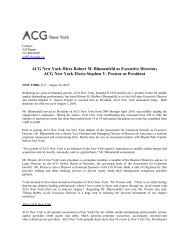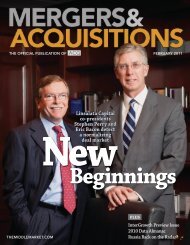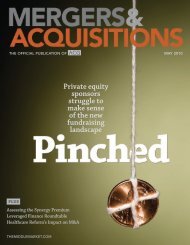September 2010 - Association for Corporate Growth
September 2010 - Association for Corporate Growth
September 2010 - Association for Corporate Growth
You also want an ePaper? Increase the reach of your titles
YUMPU automatically turns print PDFs into web optimized ePapers that Google loves.
in order to grow the company further, it meant either retooling the<br />
business model completely or partnering with a larger company,”<br />
Pope says.<br />
CCG Advisors managing partner Brian Corbett worked on the<br />
Brickman transaction. He notes that there can often be some hurdles<br />
to cross when such a disparity in size between buyer and seller exists.<br />
“The owner of a smaller business is used to being a lone ranger<br />
with no board of directors or boss,” Corbett says, adding that it can<br />
create a culture shock <strong>for</strong> both management and the employees.<br />
On the other hand, there is also less uncertainty in many cases.<br />
Alluding to the difference between large corporate buyers and financial<br />
sponsors, Corbett cites, “The strategics are known quantities….<br />
The private equity groups can be scary to smaller companies that are<br />
unfamiliar with them.”<br />
Other factors are at play that may help distinguish a large strategic<br />
as the right buyer. Chris Barnes, a managing director with Sarowdin<br />
Partners, says that oftentimes, corporate buyers may overlook<br />
certain attributes that would trigger red flags <strong>for</strong> sponsors. He<br />
recently advised on a deal in which a $200 million revenue company<br />
acquired a $40 million business. Ninety five percent of the target’s<br />
revenue was tied up with one client.<br />
“Very few acquirers can handle that type of customer concentration,”<br />
Barnes says.<br />
“The larger strategic was able to leverage that relationship,” muting<br />
the risk.<br />
At the end of the day, what makes strategics attractive is the fact<br />
that they’re out buying assets. Cobblestone’s Williams notes that traditionally<br />
he has seen dealflow at his end of the market split evenly<br />
between the corporate and financial sponsors. Over the past 18<br />
months, interest from buyers has tilted much more heavily toward<br />
the corporates.<br />
<br />
<br />
<br />
<br />
<br />
<br />
<br />
<br />
<br />
<br />
<br />
<br />
<br />
<br />
<br />
<br />
<br />
<br />
<br />
<br />
<br />
<br />
<br />
<br />
<br />
<br />
<br />
<br />
<br />
<br />
<strong>September</strong> <strong>2010</strong> MERGERS & ACQUISITIONS 13



